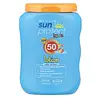What's inside
What's inside
 Key Ingredients
Key Ingredients

 Benefits
Benefits

 Concerns
Concerns

 Ingredients Side-by-side
Ingredients Side-by-side

Butane
Water
Skin ConditioningHomosalate
Skin ConditioningDicaprylyl Ether
EmollientOctocrylene
UV AbsorberGlycerin
HumectantEthylhexyl Salicylate
UV AbsorberDimethicone
EmollientButyl Methoxydibenzoylmethane
UV AbsorberStyrene/Acrylates Copolymer
Drometrizole Trisiloxane
UV AbsorberPEG-30 Dipolyhydroxystearate
EmulsifyingNylon-12
Dicaprylyl Carbonate
EmollientMethyl Methacrylate Crosspolymer
Cyclohexasiloxane
EmollientPolymethylsilsesquioxane
P-Anisic Acid
MaskingCaprylyl Glycol
EmollientDisodium EDTA
Disteardimonium Hectorite
StabilisingDodecene
MaskingEthylhexyl Triazone
UV AbsorberIsododecane
EmollientLauryl PEG/PPG-18/18 Methicone
Skin ConditioningPEG-8 Laurate
EmulsifyingPhenoxyethanol
PreservativePoloxamer 407
EmulsifyingPoly C10-30 Alkyl Acrylate
Emulsion StabilisingPropylene Carbonate
SolventSodium Chloride
MaskingTocopherol
AntioxidantParfum
MaskingButane, Water, Homosalate, Dicaprylyl Ether, Octocrylene, Glycerin, Ethylhexyl Salicylate, Dimethicone, Butyl Methoxydibenzoylmethane, Styrene/Acrylates Copolymer, Drometrizole Trisiloxane, PEG-30 Dipolyhydroxystearate, Nylon-12, Dicaprylyl Carbonate, Methyl Methacrylate Crosspolymer, Cyclohexasiloxane, Polymethylsilsesquioxane, P-Anisic Acid, Caprylyl Glycol, Disodium EDTA, Disteardimonium Hectorite, Dodecene, Ethylhexyl Triazone, Isododecane, Lauryl PEG/PPG-18/18 Methicone, PEG-8 Laurate, Phenoxyethanol, Poloxamer 407, Poly C10-30 Alkyl Acrylate, Propylene Carbonate, Sodium Chloride, Tocopherol, Parfum
Water
Skin ConditioningOctocrylene
UV AbsorberEthylhexyl Methoxycinnamate
UV AbsorberButyl Methoxydibenzoylmethane
UV AbsorberDiethylamino Hydroxybenzoyl Hexyl Benzoate
UV FilterC12-15 Alkyl Benzoate
AntimicrobialCaprylic/Capric Triglyceride
MaskingGlycerin
HumectantCyclopentasiloxane
EmollientHydrogenated Dimer Dilinoleyl/Dimethylcarbonate Copolymer
Emulsion StabilisingEthylhexyl Triazone
UV AbsorberIsohexadecane
EmollientPotassium Cetyl Phosphate
EmulsifyingSorbitan Stearate
EmulsifyingGlyceryl Stearate
EmollientPEG-100 Stearate
Phenoxyethanol
PreservativeEthylhexylglycerin
Skin ConditioningTocopheryl Acetate
AntioxidantCarbomer
Emulsion StabilisingDisodium EDTA
Sodium Hydroxide
BufferingWater, Octocrylene, Ethylhexyl Methoxycinnamate, Butyl Methoxydibenzoylmethane, Diethylamino Hydroxybenzoyl Hexyl Benzoate, C12-15 Alkyl Benzoate, Caprylic/Capric Triglyceride, Glycerin, Cyclopentasiloxane, Hydrogenated Dimer Dilinoleyl/Dimethylcarbonate Copolymer, Ethylhexyl Triazone, Isohexadecane, Potassium Cetyl Phosphate, Sorbitan Stearate, Glyceryl Stearate, PEG-100 Stearate, Phenoxyethanol, Ethylhexylglycerin, Tocopheryl Acetate, Carbomer, Disodium EDTA, Sodium Hydroxide
Ingredients Explained
These ingredients are found in both products.
Ingredients higher up in an ingredient list are typically present in a larger amount.
Also known as Avobenzone, this ingredient is a chemical sunscreen filter that provides protection in the UV-A range.
Avobenzone is globally approved and is the most commonly used UV-A filter in the world.
Studies have found that avobenzone becomes ineffective when exposed to UV light (it is not photostable; meaning that it breaks down in sunlight). Because of this, formulations that include avobenzone will usually contain stabilizers such as octocrylene.
However, some modern formulations (looking at you, EU!) are able to stabilize avobenzone by coating the molecules.
Avobenzone does not protect against the UV-B range, so it's important to check that the sunscreen you're using contains other UV filters that do!
The highest concentration of avobenzone permitted is 3% in the US, and 5% in the EU.
Learn more about Butyl MethoxydibenzoylmethaneDisodium EDTA plays a role in making products more stable by aiding other preservatives.
It is a chelating agent, meaning it neutralizes metal ions that may be found in a product.
Disodium EDTA is a salt of edetic acid and is found to be safe in cosmetic ingredients.
Learn more about Disodium EDTAEthylhexyl Triazone is a modern chemical sunscreen that protects from UV-B radiation.
It is the most effective of existing UV-B filters, as it provides the highest level of photo-stable absorption. It protects from the entire UV-B range (280 to 320nm), with it's highest level of protection at 314nm.
Ethylhexyl Triazone is oil soluble, oderless and colorless, which mean it is able to be incorporated into a variety of different formulations.
It is not currently available within the United States due to slow changing FDA regulations. Outside of the US, it is used in formulations at concentrations up to 5%.
Learn more about Ethylhexyl TriazoneGlycerin is already naturally found in your skin. It helps moisturize and protect your skin.
A study from 2016 found glycerin to be more effective as a humectant than AHAs and hyaluronic acid.
As a humectant, it helps the skin stay hydrated by pulling moisture to your skin. The low molecular weight of glycerin allows it to pull moisture into the deeper layers of your skin.
Hydrated skin improves your skin barrier; Your skin barrier helps protect against irritants and bacteria.
Glycerin has also been found to have antimicrobial and antiviral properties. Due to these properties, glycerin is often used in wound and burn treatments.
In cosmetics, glycerin is usually derived from plants such as soybean or palm. However, it can also be sourced from animals, such as tallow or animal fat.
This ingredient is organic, colorless, odorless, and non-toxic.
Glycerin is the name for this ingredient in American English. British English uses Glycerol/Glycerine.
Learn more about GlycerinOctocrylene protects skin from sun damage. It absorbs UV-B with peak absorption of 304 nm. It is a common sunscreen ingredient and often paired with avobenzone, a UVA filter. This is because octocrylene stabilizes other sunscreen ingredients by protecting them from degradation when exposed to sunlight. Octocrylene is a photostable ingredient and loses about 10% of SPF in 95 minutes.
Octocrylene also acts as an emollient, meaning it helps skin retain moisture and softens skin. It is oil-soluble and hydrophobic, enhancing water-resistant properties in a product.
Those who are using ketoprofen, a topical anti-inflammatory drug, may experience an allergic reaction when using octocrylene. It is best to speak with a healthcare professional about using sunscreens with octocrylene.
The EU allows a maximum of these concentrations:
Learn more about OctocrylenePhenoxyethanol is a preservative that has germicide, antimicrobial, and aromatic properties. Studies show that phenoxyethanol can prevent microbial growth. By itself, it has a scent that is similar to that of a rose.
It's often used in formulations along with Caprylyl Glycol to preserve the shelf life of products.
Water. It's the most common cosmetic ingredient of all. You'll usually see it at the top of ingredient lists, meaning that it makes up the largest part of the product.
So why is it so popular? Water most often acts as a solvent - this means that it helps dissolve other ingredients into the formulation.
You'll also recognize water as that liquid we all need to stay alive. If you see this, drink a glass of water. Stay hydrated!
Learn more about Water